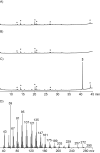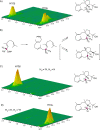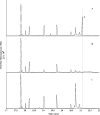18-Hydroxydolabella-3,7-diene synthase - a diterpene synthase from Chitinophaga pinensis
- PMID: 28904620
- PMCID: PMC5588592
- DOI: 10.3762/bjoc.13.171
18-Hydroxydolabella-3,7-diene synthase - a diterpene synthase from Chitinophaga pinensis
Abstract
The product obtained in vitro from a diterpene synthase encoded in the genome of the bacterium Chitinophaga pinensis, an enzyme previously reported to have germacrene A synthase activity during heterologous expression in Escherichia coli, was identified by extensive NMR-spectroscopic methods as 18-hydroxydolabella-3,7-diene. The absolute configuration of this diterpene alcohol and the stereochemical course of the terpene synthase reaction were addressed by isotopic labelling experiments. Heterologous expression of the diterpene synthase in Nicotiana benthamiana resulted in the production of 18-hydroxydolabella-3,7-diene also in planta, while the results from the heterologous expression in E. coli were shown to be reproducible, revealing that the expression of one and the same terpene synthase in different heterologous hosts may yield different terpene products.
Keywords: Chitinophaga pinensis; Nicotiana benthamiana; biosynthesis; structure elucidation; terpenes.
Figures








Similar articles
-
High-level diterpene production by transient expression in Nicotiana benthamiana.Plant Methods. 2013 Dec 12;9(1):46. doi: 10.1186/1746-4811-9-46. Plant Methods. 2013. PMID: 24330621 Free PMC article.
-
Skeletal Rearrangements in the Enzyme-Catalysed Biosynthesis of Coral-Type Diterpenes from Chitinophaga pinensis.Angew Chem Int Ed Engl. 2024 Dec 9;63(50):e202413860. doi: 10.1002/anie.202413860. Epub 2024 Oct 24. Angew Chem Int Ed Engl. 2024. PMID: 39195349
-
Functional characterisation of twelve terpene synthases from actinobacteria.Beilstein J Org Chem. 2023 Sep 15;19:1386-1398. doi: 10.3762/bjoc.19.100. eCollection 2023. Beilstein J Org Chem. 2023. PMID: 37736393 Free PMC article.
-
Opportunities and challenges for the sustainable production of structurally complex diterpenoids in recombinant microbial systems.Beilstein J Org Chem. 2017 May 8;13:845-854. doi: 10.3762/bjoc.13.85. eCollection 2017. Beilstein J Org Chem. 2017. PMID: 28546842 Free PMC article. Review.
-
Current understanding and biotechnological application of the bacterial diterpene synthase CotB2.Beilstein J Org Chem. 2019 Oct 2;15:2355-2368. doi: 10.3762/bjoc.15.228. eCollection 2019. Beilstein J Org Chem. 2019. PMID: 31666870 Free PMC article. Review.
Cited by
-
Enzyme-Catalysed Formation of Hydrocarbon Scaffolds from Geranylgeranyl Diphosphate Analogs with Shifted Double Bonds.Chemistry. 2025 Apr 22;31(23):e202500712. doi: 10.1002/chem.202500712. Epub 2025 Mar 21. Chemistry. 2025. PMID: 40067141 Free PMC article.
-
Diterpene Biosynthesis from Geranylgeranyl Diphosphate Analogues with Changed Reactivities Expands Skeletal Diversity.Angew Chem Int Ed Engl. 2022 Oct 24;61(43):e202211054. doi: 10.1002/anie.202211054. Epub 2022 Sep 21. Angew Chem Int Ed Engl. 2022. PMID: 36066489 Free PMC article.
-
Rerouting plant terpene biosynthesis enables momilactone pathway elucidation.Nat Chem Biol. 2021 Feb;17(2):205-212. doi: 10.1038/s41589-020-00669-3. Epub 2020 Oct 26. Nat Chem Biol. 2021. PMID: 33106662 Free PMC article.
-
Engineering terpenoid production through transient expression in Nicotiana benthamiana.Plant Cell Rep. 2018 Oct;37(10):1431-1441. doi: 10.1007/s00299-018-2296-3. Epub 2018 May 21. Plant Cell Rep. 2018. PMID: 29786761 Free PMC article. Review.
-
Retracted Article: Synthesis of deuterated isopentyl pyrophosphates for chemo-enzymatic labelling methods: GC-EI-MS based 1,2-hydride shift in epicedrol biosynthesis.RSC Adv. 2019 Sep 9;9(48):28258-28261. doi: 10.1039/c9ra00163h. eCollection 2019 Sep 3. RSC Adv. 2019. Retraction in: RSC Adv. 2020 Jan 27;10(8):4189. doi: 10.1039/d0ra90009e. PMID: 35530493 Free PMC article. Retracted.
References
LinkOut - more resources
Full Text Sources
Other Literature Sources
Molecular Biology Databases
